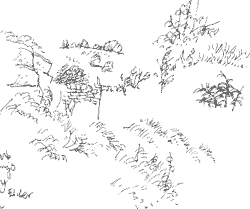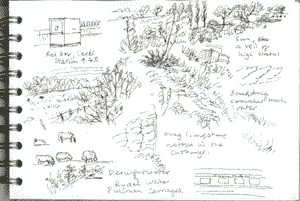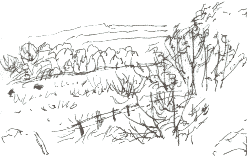|  Plants
in the railway cuttings between Batley and Morley include snowberry,
a garden escape which, as the name suggests, has white berries at this
time of year. Rosebay willowherb is now no more than
dry canes with the springy remnants of their seed cases still showing
on the stems and a few scarlet or yellow leaves clinging on lower down.
The patches of willowherb - also sometimes known as fireweed - on the
embankment are probably growing where small fires had opened the bare
soil to the light. Plants
in the railway cuttings between Batley and Morley include snowberry,
a garden escape which, as the name suggests, has white berries at this
time of year. Rosebay willowherb is now no more than
dry canes with the springy remnants of their seed cases still showing
on the stems and a few scarlet or yellow leaves clinging on lower down.
The patches of willowherb - also sometimes known as fireweed - on the
embankment are probably growing where small fires had opened the bare
soil to the light.
Buddleia bushes - another garden escape - are more common
as the railway gets into the city. Like the willowherb, buddleia colonises
waste ground.
Native plants on the embankments include occasional oak
saplings, stands of slender silver birches clinging onto
their ochre autumn leaves, dense tangles of blackberry
and bracken, a robust fern that prefers dryish slopes:
it can't compete on the richer soils on more level ground and it doesn't
do well in damp depressions or in hollows where heavy frosts can develop
as cold air rolls down slopes. Bracken fronds have mostly turned pale
straw-colour now.
 Leeds Leeds
Sycamores are now stripped of their leaves and their
bare branches, which I haven't seen for 6 months, conjure up a feeling
of waiting at bus stops on cold, dim, damp winter mornings.
There are stands of yet another garden escape, Japanese knotgrass,
extending sometimes for tens of yards in a band alongside the railway.
The best subject I can find as we pause in Leeds City station is a red
box (top left on the sketchbook page, right). More inspiring,
but flashing past too quickly to be drawn, are glimpses of older quarters
of the city like the Corn Exchange and the White Cloth Hall (dating
from 1770, see link below) as the railway follows a viaduct and embankment
eastwards out of the city centre. The line then goes through a monumentally
deep brick-lined cutting that looks as if it comes from a Gustav Doré
fantasy.
The cuttings through the creamy magnesian limestone
which we pass through before coming out onto the Vale of York have been
netted in mesh to prevent rocks falling onto the line.
 Vale
of York Vale
of York
Rather than drawing individual trees I cobble together a landscape from
elements glimpsed as the train goes by, as I did on the journey to London
a few weeks ago. Here's a field - or rather a compilation sketch of several
fields - near Church Fenton.
 These
trees (right) were sketched as we went by hedgerows and villages
on the approach to York. We were surprised to see just how high the Ouse
had risen; riverbank trees on the river side of the floodbanks were visible
as twiggy crowns sticking out of the flow. These
trees (right) were sketched as we went by hedgerows and villages
on the approach to York. We were surprised to see just how high the Ouse
had risen; riverbank trees on the river side of the floodbanks were visible
as twiggy crowns sticking out of the flow.
Some vintage Pullman carriages were being drawn out of a siding on the
approach to York. Pullman carriages are individually named, like the carriages
in one of the Thomas the Tank Engine stories. The two we saw
were 'Derwentwater' and 'Rydal Water'. I must say that, despite having
heard the forecast that there might be 4 inches of rain in the Lake District
today, when I read those names I wished that I was walking today on the
shores of one or the other of them. 
Related Link
White
Cloth Hall, Leeds
Richard Bell, richard@willowisland.co.uk |
![]()